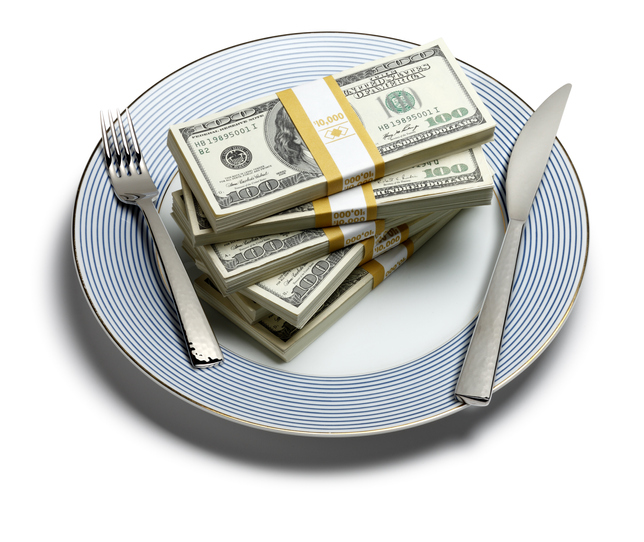Because new restaurant owners underestimate the design and construction costs for their restaurant, they usually need financing. As a quick starting point to understand the financing you’ll need to open (and run) a restaurant, here are some of the start-up and ongoing (operating) expenses you’ll have:
- Design, Construction and Permit costs
- Commercial lease (cost per month for the space of your restaurant)
- Kitchen equipment
- Furnishings (for the dining area, if you have one)
- Beginning stock and inventory (including food to begin, as well as flatware, dishes, serving utensils, linens, etc.)
- Insurance (coverage for everything from property damage to accidents and injuries)
- Wages and benefits (for employees)
- Marketing (to get people to know about your restaurant, from website and menu to flyers)
- License fees (Permits, liquor license, and other general business licenses)
- Loan repayment (to the bank or lender)
- Ongoing working capital (to cover other monthly expenses)
Here is a visual to provide a sense of the overall costs to open a restaurant – please note, these are very general figures for the U.S. and your costs will vary, depending on the particulars of your location and the details of the planned restaurant.

As you can see, it typically costs almost $400,000 to open a restaurant – including everything we outlined earlier (from construction costs to ongoing working capital). If you don’t have this cash on-hand, you’ll need financing.
Traditional financing – through a bank – requires construction documents that are ready for permitting, as well as an estimate. An investment is also required up-front to get the financing to complete the project.
The process of obtaining financing usually adds time to the process of opening a restaurant – not only for the bank approval, but also for the documents they require. Necessary documents often include:
- Federal ID and Driver’s license
- 2 years of tax returns
- Year-to-date financials
- A business plan
- Personal financials (including credit card statements and bank statements)
- All other loans or outstanding debts
- The loan application – which allows the lender to do a credit check on you/your business
While banks are the most common option for many new restaurant owners, additional financing options you to consider include:
- S. Small Business Administration (SBA) loans
- Investors
- Partners
- Personal loans
- If you’re purchasing a business from someone else, seller financing
- Family and friends
It’s also important to know that any construction or build-out change orders, due to owner changes or unforeseen conditions at a location, require special approvals by the bank. This can also add time to the day your restaurant doors open.
If you (as the restaurant owner) want to keep the job going and not be delayed by bank approvals, you should also have a contingency of at least 20% of the total budget set aside for unforeseen issues, such as building constraints (electrical, plumbing, HVAC) that were hidden before the work was started.
Based on this information, here are some tips when pursuing financing for your restaurant.
- Be sure to understand when and how you’ll be repaying your loan
If you get financing from a bank, you’ll probably need to pay back that loan on a monthly basis. Where will you find that money when you’re just starting out? Be sure to understand what you’ll be paying back very quickly (if it’s a 12 – 24 month loan, for example) so that you’ll be taking this into account as a monthly expense.
There’s nothing more disheartening than finally opening a restaurant, only to discover that you can’t make enough money to stay open after the first year because you’ve not figured out what your expenses will be.
- Avoid cash advances as much as possible
There are merchants who will offer multiple cash advances – with very high interest costs. Don’t bury yourself in this type of cycle, where you’re constantly needing money to pay back previous loans.
- Don’t sign away your future – or your parents’ (or children’s) future
Many first-time restauranteurs are so eager and excited to open their own restaurant that they’re willing to risk their homes or 401K’s to begin. We recommend that you don’t do this.
We’ve also seen parents who want to set their children up for success by selling their homes to finance a project. Again, we strongly recommend that you don’t take that big a personal risk.
- Don’t spend money before you’ve done your due diligence on ALL potential costs
All too often, we’ve seen families and relatives who have pulled their life savings or refinanced (or sold) their homes to pursue the dream of opening a restaurant, only to lose it all because they didn’t realize the up-front costs.
Before you spend any money, or sign any leases or other documents, we recommend figuring out all the costs of opening and then operating for the first few months, so that financing can cover those initial costs. That way, all your savings and hard work can be the foundation for future revenues and success.
If you’re not sure how to move forward with financing your new restaurant, we’re happy to chat with you about your specific situation to help you get started. Please contact us to help!
Resources:
https://www.touchbistro.com/blog/how-to-get-a-restaurant-loan/
https://www.webstaurantstore.com/article/74/restaurant-startup-loans.html
https://www.restaurantowner.com/public/How-to-Reduce-the-Risk-of-Opening-a-New-Restaurant.cfm

